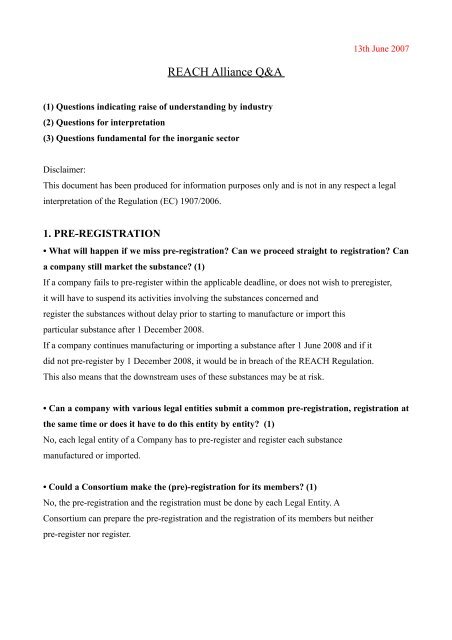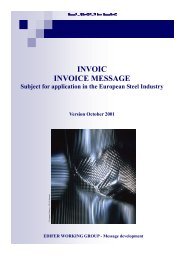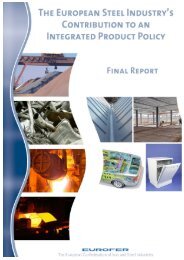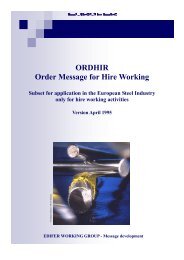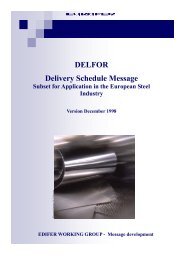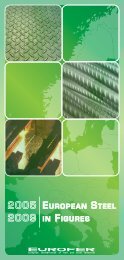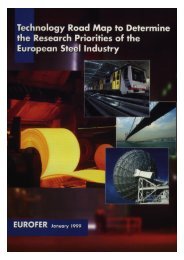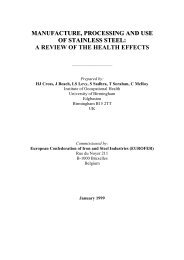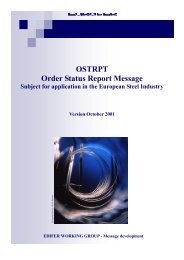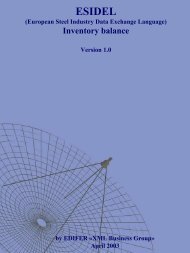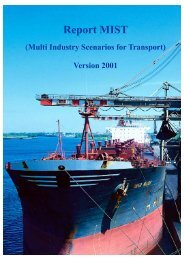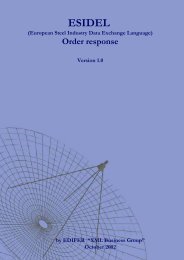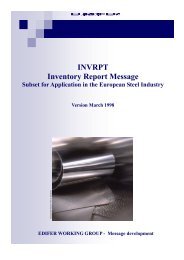Reach Alliance Q&A.pdf - Eurofer
Reach Alliance Q&A.pdf - Eurofer
Reach Alliance Q&A.pdf - Eurofer
You also want an ePaper? Increase the reach of your titles
YUMPU automatically turns print PDFs into web optimized ePapers that Google loves.
REACH <strong>Alliance</strong> Q&A<br />
(1) Questions indicating raise of understanding by industry<br />
(2) Questions for interpretation<br />
(3) Questions fundamental for the inorganic sector<br />
Disclaimer:<br />
13th June 2007<br />
This document has been produced for information purposes only and is not in any respect a legal<br />
interpretation of the Regulation (EC) 1907/2006.<br />
1. PRE-REGISTRATION<br />
• What will happen if we miss pre-registration? Can we proceed straight to registration? Can<br />
a company still market the substance? (1)<br />
If a company fails to pre-register within the applicable deadline, or does not wish to preregister,<br />
it will have to suspend its activities involving the substances concerned and<br />
register the substances without delay prior to starting to manufacture or import this<br />
particular substance after 1 December 2008.<br />
If a company continues manufacturing or importing a substance after 1 June 2008 and if it<br />
did not pre-register by 1 December 2008, it would be in breach of the REACH Regulation.<br />
This also means that the downstream uses of these substances may be at risk.<br />
• Can a company with various legal entities submit a common pre-registration, registration at<br />
the same time or does it have to do this entity by entity? (1)<br />
No, each legal entity of a Company has to pre-register and register each substance<br />
manufactured or imported.<br />
• Could a Consortium make the (pre)-registration for its members? (1)<br />
No, the pre-registration and the registration must be done by each Legal Entity. A<br />
Consortium can prepare the pre-registration and the registration of its members but neither<br />
pre-register nor register.
• Does the EU provide any documents /templates for pre-registration? (1)<br />
The pre-registration will be done via IUCLID 5 and REACH-IT.<br />
• Does pre-registration finally decide on the status of the substance? (1)<br />
Due to the high number of pre-registration dossiers, it is expected that the Agency will not<br />
have the capacity to check the status of the substance. Therefore, it is likely that the SIEF<br />
will be responsible to decide on the status of the substance.<br />
• Where and how do I need to pre-register? (1)<br />
Pre-registration takes place when the company has submitted electronically to the ECHA<br />
the required information on a substance. This information includes:<br />
-The name(s) of the substance specified in section 2 of Annex VI, i.e.<br />
13th June 2007<br />
the names in the International Union of Pure and Applied Chemistry (IUPAC)<br />
nomenclature or other international chemical name(s);<br />
other names (usual name, trade name, abbreviation);<br />
European Inventory of Existing Commercial Chemical Substances (EINECS)<br />
number (if available and appropriate);<br />
Chemical Abstract Service (CAS) name and CAS number (if available);<br />
other identity code (if available);<br />
-The name and address of the pre-registrant and the name of the contact person and,<br />
where appropriate, the name and address of a third party representative whom the pre-<br />
registrant has selected to represent him for all the proceedings involving discussions with<br />
other manufacturers, importers and downstream users (Article 4);<br />
- The envisaged deadline for registration and tonnage band;<br />
-The name(s) of other substance(s) for which the available information is relevant for<br />
performing adaptations to the testing requirements, i.e. use of results from (Q)SAR models<br />
(section 1.3 of Annex XI) and read-across approach.<br />
The online submission must be done via the REACH IT system, i.e via a web tool or via<br />
the IUCLID 5 software.
13th June 2007<br />
• Should a substance that does not have to be registered (e.g. coal) be pre-registered? (1)<br />
No<br />
• How do we know into which tonnage band a substance we use or produce in the EU will fall?<br />
(1)<br />
Calculation of the tonnage for the registration of phase in-substances that have been preregistered<br />
In the case of a phase-in substance that has been imported or manufactured for at least<br />
three consecutive years, the quantities per year shall be calculated on the basis of the<br />
average production or import volumes for the three preceding calendar years. This value is<br />
to be used for the purpose of pre-registration, unless it is estimated that by the time of the<br />
pre-registration deadline the volume will be higher than the next tonnage band. In the case<br />
that the same registrant manufactures and/or imports the same substance in different sites<br />
(i.e. in different Member States) then the volume of substance to be registered is the total<br />
of the volumes of the substance manufactured and/or imported in the different sites,<br />
because the sites are not separate legal entities.<br />
Example:<br />
If company Y wants to register a phase-in substance in April 2010, the tonnage is first<br />
calculated for the years 2008 (calculated as the average over 2005-2007), 2009 (calculated<br />
as the average over 2006-2008) and 2010 (calculated as the average over 2007-2009).<br />
The highest tonnage calculated for the years 2008, 2009 and 2010 then has to be used to<br />
determine the deadline for registration according to Article 23. This provision has been put in<br />
place to avoid situations where a sudden increase in demand would lead to the impossibility<br />
to comply with the registration obligations.<br />
The tonnage for 2010 (calculated as the average over 2007-2009) could then be used in the<br />
registration dossier.<br />
In order to be able to calculate the amount of a substance in a preparation, the total<br />
volume of the preparation is multiplied by the fraction of the constituent substance. This<br />
value can for example be obtained from the safety datasheet of the preparation. When<br />
only a range of concentrations of a substance in a preparation is available then the highest<br />
value is chosen to be the content of that substance in that preparation for the purpose of<br />
calculating the volume of substance.<br />
In the case of articles which contain a substance that is intended to be released under<br />
normal or reasonably foreseeable conditions of use, then:
13th June 2007<br />
• If the weight by weight content of that substance is known, then this value is multiplied by the<br />
total mass of the manufactured and/or imported article; or If the weight of substance per unit<br />
article is known then this value is multiplied by the total number of imported articles.<br />
This volume is then used in order to decide whether a registration must be submitted, what<br />
the information requirements are that have to be fulfilled (in accordance with the different<br />
annexes) as well as, in the case of phase-in substances, decide when the registration of<br />
the substance has to be made.<br />
For the transitional regime the tonnage to take into account is the highest tonnage<br />
manufactured and/or imported after the 1st June 2007 (taking in to account the calculation<br />
method explained above). If the level is exceeded once after 1 June 2007 this determines<br />
the tonnage band in which the substance has to be registered.<br />
Example:<br />
If the volume of Company Z is 120 tonnes (calculated as 3 years average) in 2009 and<br />
decreases to less than 100 tonnes after that, Company Z will still have to register in the 100 –<br />
1000 tonnage band, registering ultimately 31 May 2013.<br />
If the volume of Company V is 600 tonnes in 2007, 900 tonnes in 2008, 1400 tonnes in 2009<br />
and 2000 tonnes in 2010. The "3 year-average" tonnage in 2010 is 966 tonnes/year, but the<br />
"3 year-average" tonnage in 2011 is 1433 tonnes/year. In this case the company V will have<br />
to register the substance in 2011.<br />
In a similar way if a substance is used both as a non-isolated intermediate and/or as an<br />
on-site isolated intermediate and/or as a transported intermediate (provided that the<br />
relevant requirements in the legal text for intermediates are fulfilled) and is also used for<br />
other purposes, then the quantity of substance covered by the reduced registration<br />
requirements for intermediates (or exemption from REACH for non-isolated intermediates)<br />
does not have to be counted for the purpose of the registration obligation of the remainder<br />
of the substance. However, the potential registrant can also choose to make only one<br />
registration covering the total tonnage, in which case the use as an intermediate must be<br />
included in the calculation of the tonnage band and the CSR incl. development of ES and<br />
documentation of adequate control (which should not be difficult when the strict controlled<br />
conditions apply).
2. REGISTRATION (RIP 3.1/3.4)<br />
• Could a “consultant” or an “Association” take the role of Lead Registrant? (1)<br />
No, the Lead Registrant must be one of the registrants. However, the official<br />
representative for the lead registrant may be a consultant if he has been mandated by the<br />
legal entity to act on its behalf.<br />
13th June 2007<br />
• For companies with several different legal entities, will they be charged for registering each<br />
substance in each entity? (1)<br />
Yes<br />
• Do I have to register the substance or the use of the substance? (1)<br />
The substance (mentioning the identified uses in the CSR if needed)<br />
• Is the registration number linked to the substance, to the company, or both? (2)<br />
Not yet determined by the EC.<br />
• Do I have to register as a trader? (1)<br />
Trader does not exist in REACH. If a trader is an importer, yes he has to register. If a<br />
trader is a distributor, no he has to pass the information throughout the supply chain.<br />
• If you produce in “tolling” conditions, who should then register, the owner or the operator?<br />
The manufacturer has to register.<br />
• Is mechanical equipment (e.g. engines) up for registration? (3)<br />
Mechanical equipment should be dissociated into its various components. Most of them<br />
would probably be considered as articles but some could be regarded as preparations (e.g.<br />
battery???).<br />
• Can a "category registration" be made, i.e. the consortium prepares a CSR for a category of<br />
substances (e.g. several compounds of the metal). The consortium members then use this<br />
single CSR which covers several compounds of the same metal to register their individual<br />
substances? (2)<br />
No registration by category but by substance. For the CSR???, I assume that if the CSR is<br />
covering the substance to be registered you can use it in the several registration
dossiers….<br />
13th June 2007<br />
• Do “unintentional impurities” (from ores or secondary raw materials) have to be registered?<br />
What if they are CMR’s? (1)<br />
No, the Classification & Labelling of the substance must be notified to the Agency as of 1<br />
December 2010. If an impurity meets the criteria for classification and is present above a<br />
certain threshold, the substance itself shall be classified and labelled, and thus this<br />
classification and labelling shall be notified to the Agency as of 1 December 2010.<br />
• Do substances that were already registered under the "existing substances" regulation have<br />
to be registered again? (1)<br />
Yes. However, a notification in accordance with Directive 67/548/EEC shall be regarded as<br />
a registration and the Agency shall assign a registration number by 1 December 2008.<br />
• For the M/I, does pre-registration automatically mean registration? Does this mean that<br />
registration bears on the pre-registered substances, or is it possible to register as UVCB a<br />
“sum” of the pre-registered substances (which have EINECS)? (2)<br />
No, there is no obligation to register a substance that has been pre-registered. There is no<br />
clear answer to the second part, although this approach is followed for preparations.<br />
• If a substance, metal or metal compound, has already been registered at the Agency by<br />
someone else, do you still have to register it? (1)<br />
Yes (except in the case of substances in articles – see art. 7)<br />
• Do we have to register at the ECHA the substances that we import? (1)<br />
Yes, unless the substances imported into the EU have been first exported from the EU or<br />
is below 1 tonne or is exempted from registration..<br />
• No data, no market: does this mean that we have to register all substances that we can<br />
conceive of importing/manufacturing in the future? What happens if we start working with a<br />
new “material” that is phased-in and registered by somebody else after the time limits of<br />
registration have passed? We may import a substance after the end of pre-registration. Can<br />
we pre-register in anticipation of this to take advantage of phase-in timing? (1)<br />
Companies which manufacture or import substances, on their own or in preparations, or
produce or import articles containing substances in quantities of less than 1 tonne per year<br />
but which are planning to exceed the 1 tonne threshold after 1 December 2008 will also be<br />
entitled to pre-register and thus benefit from the transitional period.<br />
The pre-registration period will then start right after the first manufacturing or import<br />
exceeding the 1 tonne threshold, and will end 6 months later. However pre-registration will<br />
only be possible if it can be submitted 12 months before the relevant deadline for<br />
13th June 2007<br />
registration. First time manufacturers or importers will therefore have to submit their preregistration<br />
by 30 November 2009, 31 May 2012 or 31 May 2017, whichever is relevant in<br />
view of their tonnage threshold.<br />
• Do we have to provide information on the downstream use of materials that we sell but<br />
neither produce nor import? (1)<br />
Yes, the distributor is obliged to ensure a good communication throughout the entire<br />
supply chain.<br />
• Does registration have to take into account all tonnages placed on the market today? (1)<br />
Yes, the tonnage band should be calculated as an average over the last three years.<br />
However, if in the next years, the manufacturer or importer exceed the tonnage bands<br />
(>10, >100, >1000T), then additional information would have to be submitted.<br />
• Will the Agency accept registrations from a non-EU entity that exports into the EU? (1)<br />
No, the registrant has to be based in EU (EU manufacturer, Importer or Only<br />
representative appointed by a non-EU manufacturer)<br />
• What happens in the case of a mixture of existing substances that are registered? Must the<br />
mixture also be registered? (mixture: no chemical reaction) (1)<br />
No a preparation has not to be registered. A manufacturer or importer of a substance,<br />
either on its own or in one or more preparation(s), in quantities of 1 tonne or more per year<br />
shall submit a registration to the Agency.<br />
• Is the EU REACH System (registration) also of relevance for OECD countries? (1)<br />
NO
13th June 2007<br />
• Will Switzerland, Iceland, Lichtenstein and Norway be considered as part of the EU for<br />
registration purposes? (1)<br />
According to the corrigendum (published on 29 May 2007) of the REACH Regulation (EC)<br />
1907/2006, Iceland, Lichtenstein and Norway (EEA countries) will be considered as part of<br />
the EU for all REACH requirement, including Registration.<br />
Importers of a substance from Switzerland will have the same obligations under REACH<br />
as any other importer.<br />
• If I produce substances abroad, can I expect my customer to register these substances for the<br />
EU? Example: we use 31 metals or metal compounds. How can we check? (2)<br />
Yes, the importers are obliged to register the substances that they import above 1 tonne<br />
per year. As non-EU manufacturer, you have two solutions to ensure that you will maintain<br />
your business in EU:<br />
-Communicate with all the EU importers to ensure that they will comply with their<br />
REACH obligations.<br />
-Appoint an Only representative (art. 8) to take over the role of the importer in REACH<br />
and comply with all the REACH requirements.<br />
3. EVALUATION (RIP 4.1/4.2)<br />
• What is the timeline for dossier evaluation? (1)<br />
- 1 December 2012 for all registrations received by 1 December 2010<br />
- 1 June 2016 for all registrations received by 1 June 2013<br />
- 1 June 2022 for all registrations received by 1 June 2018<br />
4. AUTHORISATION (RIP 3.7.-3.9.-4.3/4.5.)<br />
• What could be the links or relationship between “Authorisation” and “Restriction” for one<br />
and the same substance? (2)<br />
The procedure of setting substances on Annex XIV (substances for authorisation) starts<br />
with the Annex XV dossier, under which certain uses of substances will be restricted.<br />
There is a relation between the restriction and the authorisation procedure under REACH.<br />
• Ores and concentrates: not up for registration but potentially for authorization. When<br />
should the Agency be informed?
13th June 2007<br />
There is no requirement to inform the agency about Registration or Authorisation of ores & ore<br />
concentrates. If an ore or ore concentrate is listed as a candidate for Authorisation, the Agency<br />
will publicise the listing and industry will have several opportunities to respond. The first list of<br />
candidate substances for Annex XIV shall be released by the Agency by 1 June 2009.<br />
There is a separate requirement to notify the Agency of the Classification & Labelling of ore &<br />
ore concentrates that meet the criteria for classification as dangerous as of 1 D ecember 2010<br />
• What is the difference if they are pre-registered?<br />
Ores & ore concentrates are exempt from Pre-Registration if they are not chemically modified.<br />
Pre-Registration of an exempt substance does not bring any advantage.<br />
• Likely to be on the Authorisation list? (3)<br />
No, because there are no specific EINECS entries for ores & ore concentrates for the<br />
moment, and because the Member States together with the Commission have to decide in<br />
a very complex process if a substance should be listed in Annex XIV (substances for<br />
authorisation). It is much more likely that impurities found in ores & ore concentrates could<br />
be listed for Authorisation. When this happens, there are several opportunities to introduce<br />
an exemption for the case of ores & ore concentrates.<br />
• What is the procedure if the SVHC for substances that have already been through the RM<br />
procedure under the current system? (2)<br />
There will most likely not become (first) candidates for authorisation.<br />
• Do the specific applications/uses of the SVHC accepted/covered in the RM have a<br />
« granted » Authorisation? (2)<br />
Further information is needed.<br />
• Is a manufacturer of a substance, for example a metal or metal compound, required to<br />
submit<br />
a substitution plan for the uses of his/her substance? Or is this down to the downstream user?<br />
(3)<br />
If alternatives are: identified by the manufacturer, it is technically his duty to submit a<br />
substitution plan. However, in practice the manufacturers may not know enough about the<br />
alternative(s) to propose such a plan and he would need to work closely with the
downstream users.<br />
It could be both (see Art. 62). It is the task of the applicant to come up with a substitution<br />
plan. Both, manufacturers and downstream users can apply for an authorisation.<br />
• Can you jointly apply for Authorisation (joint application – Consortium)? (1)<br />
13th June 2007<br />
Yes, the most practical and efficient approach would be for the members of a Consortium to make a<br />
joint application. Yes, see Art. 62<br />
• If Authorisation is granted, does it apply to all the M/I/DU concerned? (1)<br />
A granted authorisation applies to all of the M/I/DU who have made the application.<br />
Subsequent applicants can refer to appropriate parts of the previous application provided<br />
they have the permission of the previous applicants, but they are not automatically<br />
covered by the previously granted authorisation.<br />
Only those who have applied for an authorisation. But, subsequent applicants may refer to<br />
the appropriate parts of the previous application submitted in case of the permission of the<br />
previous applicant.<br />
• From the time the substance is on candidate list until Committee opinion, do we have to<br />
withdraw the substance from the market? (1)<br />
No, withdrawal of a substance would only result from a formal restriction or a failed<br />
application for authorisation, and then only after a specified period of time to allow a<br />
substitution plan to be put into effect.<br />
NO!!!You are allowed the substance until the so-called “sunset date” has been reached an<br />
no authorisation could have been gained. The sunset date is only applicable to substances<br />
listed in Annex XIV, but not to the substances in the candidate list.<br />
• What is the status of R&D plans in connection with Authorisation? (1)<br />
If suitable alternatives do not exist, R&D plans could form part of a substitution plan, being<br />
necessary precursor to the identification of suitable alternatives.<br />
• Is the submission of an R&D plan mandatory in connection with Authorisation based on<br />
« SEA » or on « adequate control »? (1)<br />
This is not entirely clear. Although R&D is referred to under the mandatory information<br />
requirements of Article 62.4(e), the precise wording is “…including, if appropriate
information about any relevant R&D activities by the applicant”.<br />
13th June 2007<br />
• Do « Third Parties » have to provide evidence that the alternatives are suitable? (Not just<br />
having an alternative)? What are the requirements of proof for this evidence? (2)<br />
In theory there should be proof of suitability, but the only reference in the text of REACH is<br />
in Article 64.4(b) where the SEA Committee is required to make “an assessment of the<br />
…availability, suitability and technical feasibility of alternatives”. RIP 3.9 should elaborate<br />
on this question of proof.<br />
• As a “one product company” are we expected to have a Substitution plan using a Substance<br />
that we do not manufacture and which may be a competitor’s product? This raises several<br />
legal issues under Competition Law and other… (1)<br />
In theory yes, but in practice you are unlikely to acknowledge that there is an alternative<br />
substance. If you do acknowledge that there is an alternative, you would be expected to<br />
work with the downstream users on a substitution plan. On the other hand you could<br />
submit an incomplete authorisation application and leave it to the competition or the DUs<br />
to submit a substitution plan.<br />
• Priority criteria for authorisation includes « dispersive use »: Is there a working definition<br />
for « dispersive use »? Is it clear that « dispersive use » is not the same as widespread use? (2)<br />
Yes, this has been pointed out in the SEG meeting and further comments related to RIP<br />
4.3/4.5<br />
• What is the difference in procedure between a Restriction procedure and an Authorisation<br />
procedure? (1)<br />
• Is « use as an intermediate » an exempted use from Authorisation? (1)<br />
Intermediates are not subject to authorisation (see Art. 2 (8))<br />
• What is the timing of any changes in the C&L of a substance to be implemented to its<br />
Authorisation? (1)<br />
At first, a member state or the Agency has to propose a substance to be set onto the<br />
candidate list. This process starts with the Annex XV dossier. Stakeholders and third<br />
parties are allowed to comment. If the substance finally became a candidate for
authorisation, then, based on the criteria for prioritization (will be defined in RIP 4.3/4.5)<br />
and substance can be set onto Annex XIV. This is where substances subject to<br />
authorisation are listed.<br />
13th June 2007<br />
• Will the Authorisation be dropped automatically once a substance is no longer CMR 1-2? (1)<br />
This is unlikely. The scenario does not appear to have been allowed for in the Regulation.<br />
The procedure for a withdrawal from Annex XIV in case of de-classification is actually<br />
under discussion in RIP 4.3<br />
• Period after Authorisation, is it suitable? (1)<br />
• Is there a limit for the Authorisation to be given more than once? (1)<br />
Authorisations will be time-limited, the time being decided on a case-by-case basis, and<br />
can be granted repeatedly if no suitable alternatives can be identified.<br />
• Can there be any M/I that needs to be continuously granted by an Authorisation? (1)<br />
This is unlikely to happen, since the procedure requires time-limited authorisations.<br />
• Some substances exempted from registration could still fall under Authorisation. A MS or<br />
the Agency would have to prepare an Annex XV dossier. Do they have to involve the<br />
producers/importers of the substances in the preparation of the Annex XV dossier? (1)<br />
No involvement in the preparation of Annex XV dossiers. Industry comes into play after the<br />
finalisation of Annex XV dossier. They can then oppose to stop the procedure of setting<br />
the substance on the candidate list.<br />
5. NOTIFICATION OF CLASSIFICATION AND LABELLING, GHS AND<br />
MSDS (RIP 3.2, 3.3, 3.6)<br />
• What is the procedure in cases where no toxicity data exist and you need to notify the<br />
classification of a substance? (1)<br />
Data needs prescribed by REACH need to be filled. Where no data exist, they need to be<br />
generated. For vertebrates testing, permission is needed from the Agency. The collected<br />
data can then be used to classify the substance.<br />
For substance falling outside the scope of registration, authorisation, classification is
ased on the available data! There is no obligation under REACH to generate such data.<br />
13th June 2007<br />
• If there is no agreement on classification, in the EU, the ECHA will register the various<br />
entries.<br />
In the EU-GHS, the system works on a “first-come, first-served” basis: the first 2 or more<br />
companies notifying Classification will be considered as prima facie. The next ones with a<br />
different entry will have to provide justification. What are the recommendations for C&L:<br />
notify asap? (2)<br />
It is recommended to base any classification proposal on a good scientific basis. Any classification<br />
proposal will need to be justified. Where differences appear, the different registrants will be asked<br />
to come to a harmonised classification.<br />
REACH says that in case of various entries, the notifiers shall make all possible efforts to<br />
agree on a common entry. This shall be discussed in the SIEF and is indeed one of the<br />
two objectives of the SIEF. Where registration is not required, there will be no SIEF and<br />
therefore the possible agreement should be sought outside the "SIEF rule".<br />
Also, if the substance is regarded as of high concern by a Member State, this Member<br />
States may request the harmonisation by the EU Competent Authorities.<br />
However, the GHS draft locked in the first classification agreed by 2 or more parties. This<br />
is a serious issue that should be resolved during the co-decision procedure for GHS !!!<br />
• Do we need to update our SDS at midnight on 31 May 2007? (2)<br />
This has been discussed at the last CWG meeting (March 2007) where Industry asked for<br />
a pragmatic and flexible approach to enforcement, stressing the pure administrative nature<br />
of the changes (CEFIC).This has been supported by several Member States. Conclusion<br />
was that the content, not the format of the SDS is the priority for the enforcement and that<br />
the changes required by REACH i.e. the changed order of chapters 2 and 3 and the<br />
addition of the e-mail address can be introduced when (substantial) changes/up-dates are<br />
made of the SDS. A substantial change could be the classification according to GHS or the<br />
addition of exposure scenarios. The changes required by REACH should however be<br />
introduced before the first dead-line for registration on 1 December 2010.
6. CHEMICAL SAFETY REPORT (RIP 3.2.)<br />
13th June 2007<br />
• How many Exposure Scenarios will be needed in general for a substance (10, 100, 1000)? (2)<br />
This is difficult to say; it depends on the substances and it specific uses. Eurometaux is<br />
developing generic exposure scenarios which are aimed to cover as much as possible<br />
uses at the same time, so as to reduce the number of exposure scenarios.<br />
• What about the foreseeable non-compliance of the consumer with RMMs (most will not read<br />
the instructions)? Does this have to be considered? (2)<br />
Risk management measures are generally not intended for the consumers. If exposure<br />
and so risks to consumers needs to be managed, it will be up to the producer of these<br />
articles to ensure that the exposure is limited during the use of the substance by the<br />
consumer. For example, coatings could be applied to a metallic surface where dermal<br />
exposure is to be prevented to the metal.<br />
• How does a M/I get exposure data from end-of-life processes (e.g. copper smelters, waste<br />
processes, recyclers)? (2)<br />
By ensuring good communications before and after the registration deadline: During the<br />
preparation of the chemical safety report, M/I need to set-up good communications with<br />
the downstream users so that exposure data can be collected from the downstream users<br />
and end of life. From the final chemical safety report, the M/I will extract the relevant<br />
exposure scenarios and add these to the MSDS. The DU when receiving the MSDS needs<br />
to check the exposure scenario relevant for his activities. Where the exposure assessment<br />
is too high, the DU communicates this back to his supplier who passes the relevant info up<br />
the supply chain to the M/I so that the latter can update the exposure assessment and<br />
exposure scenario.<br />
• Where in the production chain does the risk calculation stop? When the substance is turned<br />
into an article? (1)<br />
Risks due to exposure to the substance are assessed for the ENTIRE life cycle of the<br />
substance. This includes when used in an article and when disposed of (end of life).<br />
• What about ES coming from other sources of emission than those caused by activity in<br />
charge of the dossier (e.g. metals from fossil fuel burning)? (3)<br />
The chemicals safety report addresses only the intended uses of the tonnage marketed.
Metals released during fossil fuel burning needs to be addressed by the exposure scenario<br />
for fossil fuels and are so part of the fossil fuel chemical safety report.<br />
7. SIEF (RIP 3.4.)<br />
• What are the differences between SIEF and consortia formation? (1)<br />
The SIEF is an obligation described in REACH (see art. 29), a consortium is a voluntary<br />
form of cooperation of the Indsutry.<br />
• What is the benefit of entering a SIEF? (1)<br />
You have no choice to enter or not in a SIEF. The participation to a SIEF is mandatory.<br />
• Will the ECHA play a role in SIEF and consortia? (2)<br />
No, it is up to the Industry to organize itself.<br />
• Can an « only representative » represent more than one non-EU manufacturer? (1)<br />
It should be noted that the “only representative” would not be covering the registration<br />
duties for the same substance manufactured by another non-EU manufacturer; if the<br />
importer obtains the substance from a number of non-EU sources he may still have to act<br />
as registrant. The question is still under discussion in the Commission.<br />
13th June 2007<br />
• Who decides what are acceptable quality and relevant tests (studies)? In particular in a<br />
SIEF? (2)<br />
The registrants decide on what is relevant or not. Some mechanisms to (e)valuate the<br />
existing data are under development in RIP 3.4.<br />
• Web site addresses for SIEFs? (1)<br />
No website addresses. As soon as you have pre-registered you will be in on a list with the<br />
other pre-registrants of the “same substance”. After this up to the industry to organize<br />
itself.<br />
• Are there any specific rules about how the costs have to be shared within a<br />
consortium/SIEF? (2)<br />
REACH mentioned that the “participant(s) and the owner shall make every effort to ensure<br />
that the costs of sharing the information are determined in a fair, transparent and non
discriminatory way”. In case of disagreement, the default mechanism will be “equal share”.<br />
RIP 3.4. is actually developing some guidance on how to share the cost in a “fair,<br />
transparent and non-discriminatory way”. This guidance will be available after the EIF.<br />
8. IDENTIFICATION OF SUBSTANCES (RIP 3.10.)<br />
13th June 2007<br />
• If one and the same substance is manufactured on the one hand, and naturally occurring on<br />
the other, the first one has to be registered, but not the second one. (3). E.g.: Diamonds fall<br />
under the heading “minerals not chemically modified”, but what about synthetic diamonds<br />
that do not occur naturally?<br />
Minerals, ores, ore concentrates (etc.) which occur in nature, if not chemically modified,<br />
are exempted from registration according to Annex V. Although this is not explicitly the<br />
case for their equivalent produced by a manufacturing process (at least in the REACH<br />
Regulation) RIP 3.10 clearly states that provided the composition is similar and the toxicity<br />
profile identical, both will be identified as the same substance. However it is added that<br />
this “does not necessarily mean that the legal requirements (e.g. exemptions from<br />
registration) are the same”. The review of Annexes IV & V by the Commission could clarify<br />
this aspect.<br />
• Does the impurity ruling for mono- and multi-constituent substances also apply, e.g. 10% in<br />
the case of substances of high concern? (2)<br />
RIP 3.10 states that although only impurities present in a concentration =1% should be<br />
specified, impurities that are relevant for classification shall always be specified (e.g. any<br />
carcinogen category 1 shall be specified in present in concentration above 0.1%).<br />
• What if the “impurity” has a valuable function (for the user), is specified in the contract, and<br />
payment is requested? (2)<br />
In the RIP 3.10, an impurity is defined as follows: "unintended constituent present in a<br />
substance as produced. It may originate from the starting materials or be the result of<br />
secondary or incomplete reactions during the production process. While it is present in the<br />
final substance it was not intentionally added. Also, an impurity would be present in<br />
quantity below 10%. However, a manufacturer/importer may decide to register his<br />
substance as multi –constituents substances, the "valuable impurity" being then identified<br />
as a valuable constituent.
• Is there a possibility to justify reasons for deviation from the 80% rule? What kind of<br />
justification would be acceptable? (2)<br />
RIP 3.10 clearly states that the 80% rule is a rule of thumb and that deviation is possible<br />
but has to be justified.<br />
Examples of justification:<br />
For mono-constituent substances :<br />
13th June 2007<br />
- the main constituent is < 80% but the substance can be shown to have similar<br />
physicochemical<br />
properties and the same hazard profile as other mono-constituent substances with the same<br />
identity that fulfill the 80% rule.<br />
-The range of concentrations for the main constituent and the impurities overlap the 80%<br />
criterion<br />
and the main constituent is only occasionally 80%.<br />
For multi-constituent substances:<br />
- a substance contains two constituents, one at 85% and another at 10%, the balance being<br />
impurities. Both constituents contribute towards and are essential for the desired technical<br />
effect of the substance. In this case, despite one constituent being present at > 80%, the<br />
substance can be described as a two-constituent substance.<br />
• MCS: if a constituent is never supplied separately to the bulk substance, would it have to<br />
undergo tests individually, or is it OK to test it as part of the MCS only? (2)<br />
REACH requires the registration of a substance as produced. Therefore you may test only<br />
the bulk substance. However, you are offered the possibility to register constituents of a<br />
substance separately as there is no need to test the substance as such, if its hazard profile<br />
can be sufficiently described by the information of the individual constituents.<br />
• How do you deal with a substance containing >80% one substance and >10% of another<br />
substance? Will this be considered a mono-constituent substance, or can you choose how to<br />
consider it? (2)<br />
In accordance with the above example (see box), you may choose how to consider it.<br />
• Scrap and waste: Is scrap defined? Not considered as a waste? (3)<br />
Waste is clearly excluded fro the scope of REACH. However, the waste / not waste issue<br />
is not a matter for REACH. This issue is currently discussed under the revision of the
Waste framework Directive where the concept of by-product will be introduced and<br />
defined. By-products placed on the market are within the scope of REACH.<br />
13th June 2007<br />
• Difference between the 2nd approach MCS (name mixture) and a preparation (mixture in<br />
GHS)? Difference between a preparation assessed on its own and a first approach MCS? (2)<br />
RIP 3.10 indicates that the difference between preparation and multi-constituent<br />
substance is that a preparation is gained by blending of two or more substances without<br />
chemical reactions, while a multi-constituent substance is the result of a chemical reaction<br />
(RIP 3.10 acknowledges that this is not the case for minerals, which can be treated either<br />
as mono- or multi-constituent substances).<br />
• Could you provide an example of each of the following categories: substance, preparation,<br />
multi-constituents substance, mono-constituent substance, alloy, article, intermediate? (1)<br />
Substance:<br />
- Mono-constituent: Calcium oxide, Copper, Chlorite, Quartz, Boric acid<br />
- Multi-constituents: Cement-clinker<br />
-UVCB: feldspar, bentonite, kaolin<br />
Preparation: paint, ink, milk of lime, mineral slurries<br />
Alloy: an alloy is a special preparation (e.g. steel)<br />
Article: a plaster Board, a sheet of paper, a ceramic plate<br />
Intermediate: In some paper mill, lime is produced in-situ and then converted into calcium<br />
carbonate. In this example, lime is an intermediate.<br />
9. REACH IT (RIP 2)<br />
• IUCLID 5 could run on a PC, but what is the size of IUCLID 5? (1)<br />
- The installation kits are 70-100 MB<br />
- The EC inventory is about 20 MB<br />
- The full set of reference substances (with structure images) are ca 500 MB<br />
- The database size needed for the application depends of course on the amount of<br />
data that needs to be stored.<br />
- IUCLID stores attachments inside the database, the size of a substance or dossier<br />
is around 2 MB + the size of the attachments.<br />
• When you submit your dossier, you need an ID and password; when does the password
arrive with pre-registration number? (1)<br />
The person who submits a dossier is not necessarily the same as the person who takes<br />
care of Pre-registration. This means that there will be a ‘User Account creation process’ to<br />
take care of this. I did not see the requirements of the REACH-IT system for creation of a<br />
User Account<br />
13th June 2007<br />
• RMM will be obligatory with REACH; will standard phrases be developed for this,<br />
comparable with risk and safety phrases? (2)<br />
Yes<br />
• What will be visible to whom in REACH IT? Can the registrants check/consult the part of<br />
the dossier submitted jointly? (1)<br />
No<br />
10.READ-ACROSS/CATEGORIES (RIP 3.3)<br />
• Many metals underwent formal or voluntary RA under the ESR, and many tests were<br />
waived under this programme. Do those that were waived remain valid, especially for C&L<br />
requirements for 10 T/yr.


